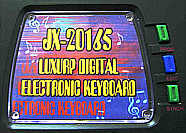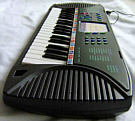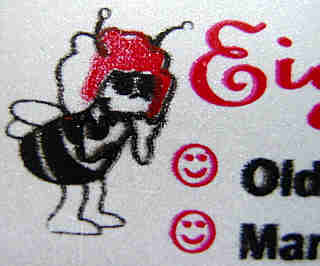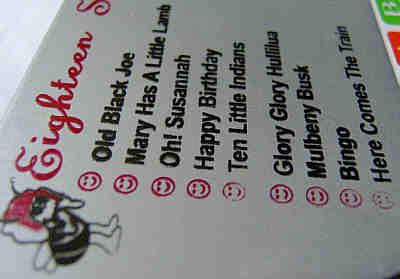
| Jin
Xin Toys JX-20165
(great My Music Center variant with lots of grainy lo-fi timbres and programmable rhythm) |
|
What comes out
when we cross a "luxury digital electronic keyboard" with a burp?!
|
This really bizarre tablehooter made in China is full of such Engrish misspellings and the case is a blatant imitation of a Casio SA-65. But inside this instrument is based on the classic My Music Center toy keyboard sound generator and shares with it many of its great low-fi samples and the grainy envelope zipper noise, but it features all together 36(!) different main voice sound variations, programmable drum pattern and 16 rhythms with optional fixed key accompaniment. The sounds are variants of the My Music Center and the Musical Centre sound bank (including the lovely square vibrato). Unfortunately at least in unmodified state a keyboard matrix flaw prevents to play certain notes simultaneously despite it is 2 note polyphonic.
 |
 |
(Note: This keyboard has nice digital synth timbres, but don't buy one of these so far your only intention is to get a keyboard with faithfully imitated natural instrument sounds. This is a grainy lo-fi instrument and many of its sounds don't sound at all like what their name suggests, thus bought with wrong expectation it may disappoint you.)

The box shows a silver or light grey version. |
 |
The Jin Xin Toys JX-20165 is one of the most "professional" designed My Music Center variants, although it has not the fast and perfectly working CPU like the astonishing Medeli MC-32 but still the same slightly sluggish key response and only 2 note polyphony like the original. By its sounds I would regard it rather as a direct successor of the great Musical Centre toy keyboard and it even has the same start-up jingle. Unlike My Music Center, the JX-20165 is stereo, i.e. the sounds have 3 different panning positions {left, middle, right}, which is particularly used by the rhythms.
Like with My Music Center all timbres have a volume envelope with well audible ticking zipper noise and most contain a chorus effect with slow tremolo. Especially the high notes of the "trumpet" have strong aliasing noises those produce disharmonic overtones similar like a ring modulator, although here it seems to be less extreme than with the original My Music Center. The "guitar" sounds like a cross between sitar and banjo and has a very strange and buzzy, wire- like roaring bass range. The "mandolin" rings. The "bell" is rather a vibraphone and the "synth" is a continuous tone version of its timbre (like an organ). The "vibraphone" sounds way too harsh (rather sitar- like). The "e.piano" sounds more like a banjo, while the "banio" is harsher and decays faster. The "organ" is more a harsh accordion while the "violin" is a duller and warmer version of it. The piano sounds more realistic (although honky- tonk- like) than the one of many early non- toy keyboards. The "musicbox" is particularly great for new age style musics. The "flute" has a nicely realistic weak hiss component and resembles wooden organ pipes. The "saxphone" resembles more a reed organ or melodica. The "flute" and "saxophone" are also the only sounds those without chorus effect and without long release phase. All other timbres contain much sustain which prevents playing short blipping notes, but due to the slow keyboard scan frequency this is anyway nothing this instrument can do particularly well. By pressing the "edit" button, a cute and cheesy square vibrato can be added to all these sounds, which also disables the chorus effect and thus basically doubles the number of available sounds.
Unlike Musical Centre, the 4 effect sounds of the JX-20165 can be also combined with rhythm now. The only difference to normal sounds is that they can not be used with vibrato and not be selected during the demo melodies. The the "ghost" sound is a fading tone with long attack phase like a bowed glass, but with very strong square vibrato. Unlike the wonderful ghost sound on Musical Centre, here the pitch unfortunately ascends like a siren, which makes it less usable for melodic play. The "ambulance" is a tone that toggles between 2 notes; quite interesting is that the toggle timer resets by every new note, thus it does not toggle during fast play or trilled notes, which permits some interesting play techniques. The "ambulance" is a harsh siren. The "telephone" is a fast digital dual tone telephone ring sound which ends after about a second. In comparison to Musical Centre these sounds ring or howl a bit slower.
The JX-20165 has a programmable drum pattern (custom drummer) similar like the Letron MC-3 (see there), but this one is far more restricted, because once the user pattern is entered (using drumpads and the "play" button for pauses), it starts immediately and can not be stopped again without deleting the pattern. The only thing you can do with it is restarting the pattern from step 1 by pressing "play", or starting and stopping accompaniment or selecting a new accompaniment. All percussion are all quite thin low- res samples, but they sound at least a little cleaner than the My Music Center percussion despite the drum kit ones seem to be recorded from the same sounds. The animal samples are slightly different; e.g. the frog croaks faster, more impulsive and sounds nice for tekkno.
Very bizarre is also that during accompaniment a sustain is added to the main voice, which prolongs its release phase (very noticeable with "flute" and "saxophone"); apparently it was intended to affect only the 2nd polyphony channel (which plays the accompaniment) but instead it is applied to both. Another very bizarre pug is that while the user pattern of the custom drummer is playing, the chorus of the main voice is disabled (thus by entering an empty pattern it can be intentionally disabled without playing a rhythm).
All preset sounds, preset rhythms and demo melodies are selected by pressing a corresponding selection button (its LED lights up) and entering a 3 digit number. Strange is that any of these numbers begin with a leading "0" and contain no "0" in any other digits, thus technically this zero seems to be rather a sort of state machine reset command than part of the number itself. Rhythms can be played with or without their accompaniment (here mislabelled "chord") and even the accompaniment can play with rhythm off. Unfortunately some design flaws make the selection very un- OBS and contra- intuitive. Also the button placement and colour is everything but logical, the writing is badly readable under dim light and with rhythm and accompaniment off all button presses make a loud beep.
To select a rhythm, press "rhythm" ( =>rhythm LED lit), enter its 3 digit number and press "start" to start it. No different preset sound can be selected so long the "rhythm" or "chord" LED is lit (because in this state entered numbers would only select a different rhythm). Unfortunately the "rhythm" LED always stays lit until you press "rhythm" again to unlight it, but this also stops the rhythm. Thus press "start" again to restart rhythm and now you can select sounds while rhythm keeps running. But when you press "chord" to start accompaniment, the rhythm LED lights up again. You can now even press "rhythm" to mute the rhythm (which unlights the rhythm LED) and only keep the accompaniment, but entering a number will despite switch only the current rhythm (of which the accompaniment is playing), thus it is impossible to select a main voice sound while accompaniment is on. To me this looks rather like one of these light puzzles on old pinball machines than a user interface. ;-) When a new rhythm is selected, the change takes effect with a delay because it waits always on the end of the current bar. The good thing of the rhythms is that you can quickly mute rhythm and accompaniment individually with OBS buttons and even quickly exchange back and forward the rhythm drum kit with the 4 animal samples by pressing "drum", which permits quite interesting realtime tricks for live play (but other keyboards can do way more OBS things).
 The
hardware consists of a couple of small PCBs interconnected with grey ribbon
cables. The speakers are 3W types with reasonable large magnets. The CPU
is a COB module with clock frequency resistor much like in My Music
Center, and like the latter it makes many bizarre sound glitches and
crash noises, particularly with empty batteries. Unfortunately a keyboard
matrix flaw prevented to play certain notes simultaneously despite it is
2 note polyphonic. The flaw can be fixed by soldering a diode into each
of the 5 output lines (center ribbon cable) of the keyboard PCB, and from
each of its input lines (right ribbon cable) a pulldown resistor (I used
18 kOhm) against GND. I also inserted a diode into each drumpad line to
prevent matrix mess when drumpad buttons and keys are pressed together.
The power adapter jack hummed badly with unregulated power supplies, thus
I added a 7809 voltage regulator with 2200µF capacitor (see speaker
screw to the right); now it plays perfectly. I also re- arranged the green
and blue buttons. I haven't fully analyzed the keyboard matrix yet, but
there seem to be no higher note keys addable because function buttons share
the same row with the highest keys.
The
hardware consists of a couple of small PCBs interconnected with grey ribbon
cables. The speakers are 3W types with reasonable large magnets. The CPU
is a COB module with clock frequency resistor much like in My Music
Center, and like the latter it makes many bizarre sound glitches and
crash noises, particularly with empty batteries. Unfortunately a keyboard
matrix flaw prevented to play certain notes simultaneously despite it is
2 note polyphonic. The flaw can be fixed by soldering a diode into each
of the 5 output lines (center ribbon cable) of the keyboard PCB, and from
each of its input lines (right ribbon cable) a pulldown resistor (I used
18 kOhm) against GND. I also inserted a diode into each drumpad line to
prevent matrix mess when drumpad buttons and keys are pressed together.
The power adapter jack hummed badly with unregulated power supplies, thus
I added a 7809 voltage regulator with 2200µF capacitor (see speaker
screw to the right); now it plays perfectly. I also re- arranged the green
and blue buttons. I haven't fully analyzed the keyboard matrix yet, but
there seem to be no higher note keys addable because function buttons share
the same row with the highest keys.
Unfortunately the Jin Xin Toys JX-20165 seems to be very rare; I only saw them once in a Turkish shop and the used specimen I bought was the only one I ever saw on eBay. Apparently a predecessor of it was the Great Performance keyboard (same case, blue control panel without drumpads, left 5 keys are fake and simulate drumpads, seen on eBay), which contains crippled My Music Center hardware with only 6 preset sounds and 4 rhythms (by omitted buttons). Another great non- toy My Music Center successor was the Medeli MC-32 (49 midsize keys, clever 4 note polyphony, many samples), but it appears to be the same way rare too.
Likely a direct successor of the JX-20165 hardware (with 22 preset sounds, 25 preset rhythms, 6 demos, including those names from JX-20165) was released in the toy keyboard Measureless Livingly Electronic Organ NO.22368 (?, white with red/ blue, comes with plastic stand and stool, seen on eBay). A Yongmei YM-2100 version with slightly different case shape was released as "JT-2028 - Lucury Computed Electronic Keyboard", which by its name was certainly also released by them. Jin Xin Toys released also the absurdly bad toy tablehooter Lovely Music-Keyboard NO.20185, which like the JX-20165 had a blue pseudo- display window in a Casio- inspired case (silver metallic, shape resembles Simba 683 3149). But despite microphone jack and wannabe noble design it has no volume control and only 1 monophonic ear- tormenting harsh and grainy squarewave musicbox sound. The 18 OBS buttons only start the 18 demos (same sound in 2 note polyphonic) and the rightmost 13 of the 37 midsize keys are even unusable because the notes are in wrong order (instead of forming an octave, all flat (white) keys have a semitone distance, and like Xin Anda - 8-Melody Letter Study Piano the sharp keys are wired parallel to the adjacent flat key in that section). The silver metallic control panel of my brand new specimen was very scratched and its writing crooked, badly smeared, and rastered like printed with a early 1980th 9 needle matrix printer. Impressive is only the noble looking bluish fluorescent plastic window, which under day light shines like illuminated by blue LEDs. The package box is labelled "SIMULAT - Luxury Music Keyboard" ("SIMULAT" like in "simulated", in the meaning of fake???) and the keyboard picture on it has a more colourful control panel writing than the actual keyboard (with the red name "Music Keyboard" and butterfly instead of bee icons). This tablehooter was also released by Interkobo with box labelled "INTERKOBO - JUNIOR MUSIC MLODY MUZYK"(?).
 |
 |
 |
 |
| removal of these screws voids warranty... | ||
 |
||
|
|